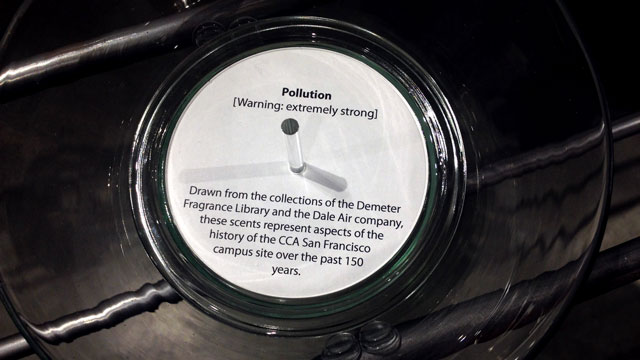On a recent evening in San Francisco, a couple dozen well-dressed and hiply bespectacled young people leaned over glass cones and inhaled. The purpose? Time travel.
At Urban Olfactory, an exhibition running at the San Francisco Planning and Urban Research Association (SPUR) through March 31, you can breathe in the smells of Paris from 1738, the odours of a 12th-century citron harvest, the pungent aroma of the New Jersey Turnpike, and more. It’s all contained in a few small white squares of scented fabric at the bottom of the glass cones — each scent an olfactory snapshot from the past.
There is no Polaroid for smells, of course (unfortunately), and Urban Olfactory is not a real historical archive. But the idea was to imagine one, David Gissen, the exhibition’s co-curator with Irene Cheng, told me. Previously, Gissen had speculated fantastically about “urban ice cores,” or an archive of indoor air for future urban climatologists. The dozen or so scents at Urban Olfactory range widely in time and space, from early modern Europe to the California of 50 years ago.

Assembled largely from the collections of perfume makers, the scents are certainly not all pleasant. “Paris 1738,” inspired by the novel Perfume, reeks of a filthy city before modern sanitation: “foul breath, human body stink, and overflowing gutters.” (It smells as unpleasant as it sounds.) Today, the conveniences of modern toilets and showers mean that we rarely have to encounter the stink of the the human body and its various excretions. Inhaling the recreated odours of Paris 1738, I wondered how infrastructure could alter not only the landscape of a city, but its smellscape, too.
To use a more modern example, what about air pollution? A television screen on the wall at Urban Olfactory played a video of Terroirs déterritorialisés, a project recreating the atmosphere of Paris on a spring day in 1832 before the first coal factory. However, the soothing wood and stone scents chosen by architect Philippe Rahm for the project were, as Gissen put it, a bit romanticized for an era before sewage.

Even more interesting is how these foul smells then influenced a city’s physical development. Beginning in the 18th century, Paris’s fetid odours motivated urban infrastructure projects like street paving and sewage construction so that human waste could be out of sight. Early urban zoning laws put foul-smelling industries at the periphery of the city.
The closest we’ve come to an olfactory archive, as far as I can tell, is a call for proposals by DARPA for what they term as “chemical cartography.” The idea is to map a city’s scent with sorbent tubes, so that the presence of suspicious chemicals could reveal a stockpile of chemical weapons. Such an archive could, of course, interest future historians, too, as they might chart the decline of coal plants or the rise of urban farming.
The top image in this post is of the exhibit as it originally appeared at the California College of the Arts. Thanks to the CCA and photographer Jim Norrena. All other photos by me.
